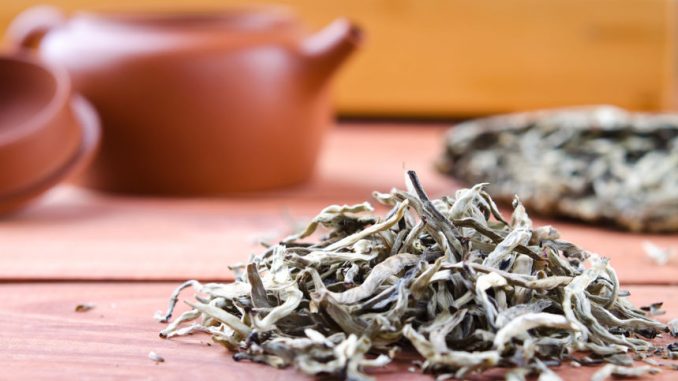
White tea is a relatively new product in the long history that is tea drinking. It is a particular type of tea that is made from young or minimally processed leaves of the Camellia sinensis shrub.
For many connoisseurs of tea, the definition of white tea is woolly and ill-defined. International agreement as to what it truly is still remains to be established. When it is brewed it produces a pale yellow brew. It is thought that the name ’white’ comes from the silvery white hairs to be seen on the unopened buds of the tea plant. These give the buds a silvery-white sheen. Even the unopened buds are used for various forms of white tea.
Processing
The main feature of white tea is the low level of processing used in its creation. The tea is harvested before the leaves are fully open and the buds have this white sheen. The tea is handpicked from the newest growth. The leaves are dried carefully to avoid oxidation. There are no further steps associated with fermentation, roasting or to any ‘withering’ as described in prolonged processing. Further drying oxidises the leaves further and generates the green and black teas which we are more familiar. When the leaves are processed further, they are broken and crushed. This releases enzymes such as polyphenol oxidases and peroxidases which convert the endogenous catechins in the leaf to a number of important compounds such as theaflavins, thearubigins, and other complex polyphenols (Dai et al., 2017).
The main production sites are in China, especially Fujian province which specialises in the product. Other commercial centers now include Nepal, Taiwan, parts of Sri Lanka such as Galle, India and Northern Thailand.
Some of the most popular tea varieties are:-
Bai Mudan (White Peony): A recent introduction of white tea now cultivated in most tea growing areas. It is usually cultivated from a Chinese white tea bush or other variety. It usually includes a few buds blended with unfurled or barely opened young tea leaves.
Bai Hao Yin Zhen (Silver Needle): The true Silver Needle tea is produced only in the Fujian province of China and is cultivated from the original cultivars making up China’s white tea plant. It is prepared from large, full buds that are covered with white, downy hairs giving this tea its famed silver colour.
Darjeeling White Tea: A variety not cultivated from the original Chinese white tea plant variety but from tea plants native to the Darjeeling region of India. The processing method is similar to the Fujian white teas, but the flavour profile is very different to other white teas.
Monkey Picked White Tea: Once thought to be harvested by monkeys trained by Buddhist monks who could reach the leaves in the highest wild tea tree tops of mountainous regions of China. The “monkey-picked” term is used today to denote a very high-quality Chinese tea made from the buds and young leaves of the tea plant.
Health Benefits
Tea of any sort has claimed to have many different health benefits. Where do you start ? It has the following ascribed to it:-
- antioxidant (Zhong et al., 2016)
- anticancer,
- antibacterial (Toda et al., 1991),
- antifungal,
- antitoxoplasmal,
- antitrypanosomal,
- anticoccidialactions
One of the most interesting benefits is the claimed effect of preventing cancer which was ascribed to green tea in particular (Fujiki et al., 2015; Lazzeroni et al., 2017) but may well apply to white tea. It would also be interesting to see if white tea has the same benefits as both green and black tea in weight management plans.
References
Dai, W., Xie, D., Lu, M., Li, P., Lv, H., Yang, C., … Lin, Z. (2017). Characterization of white tea metabolome: Comparison against green and black tea by a nontargeted metabolomics approach. Food Research International, 96, pp. 40–45. https://doi.org/10.1016/j.foodres.2017.03.028
Fujiki, H., Sueoka, E., Watanabe, T., & Suganuma, M. (2015). Primary cancer prevention by green tea, and tertiary cancer prevention by the combination of green tea. Journal of Cancer Prevention, 20(1), pp. 1–4 https://doi.org/10.15430/JCP.2015.20.1.1
Lazzeroni, M., Guerrieri‐Gonzaga, A., Gandini, S., Johansson, H., Serrano, D., Cazzaniga, M., … Bonanni, B. (2017). A presurgical study of lecithin formulation of green tea extract in women with early breast cancer. Cancer Prevention and Research (Phila), 10(6), pp. 363–370. https://doi.org/10.1158/1940-6207.CAPR-16-0298
Toda, M., Okubo, S., Hara, Y., & Shimamura, T. (1991). [antibacterial and bactericidal activities of tea extracts and catechins against methicillin resistant staphylococcus aureus]. Nihon Saikingaku Zasshi, 46(5), pp. 839–845. PMID:1762174 (in Japanese)
Zhong, R. Z., Zhou, D. W., Tan, C. Y., Tan, C. Y., Tan, Z. L., Han, X. F. … Tang, S. X. (2016). Effect of tea catechins on regulation of antioxidant enzyme expression in h2o2‐induced skeletal muscle cells of goat in vitro. Journal of Agricultural and Food Chemistry, 59(20), pp. 11338–11343. https://doi.org/10.1021/jf202839t
Leave a Reply